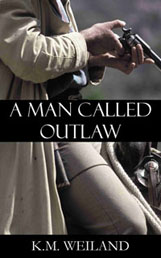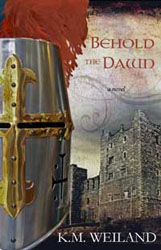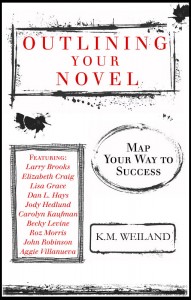 Last winter when I was trading guest posts with the other Top 10 Blogs for Writers, K.M. Weiland and I swapped posts on 5 Writing Rules Your Should Break and The 4 Most Common Mistakes Fiction Editors See. She’s been extremely busy since then, as I’ve discovered, and now she’s back with us for today’s release of her own book on writing, Outlining Your Novel: Map Your Way to Success. In fact, she’s holding a drawing on her site, Wordplay, of a whole variety of stuff, including an e-version on my new book, The Art & Craft of Story: 2nd Practitioner’s Manual.
Last winter when I was trading guest posts with the other Top 10 Blogs for Writers, K.M. Weiland and I swapped posts on 5 Writing Rules Your Should Break and The 4 Most Common Mistakes Fiction Editors See. She’s been extremely busy since then, as I’ve discovered, and now she’s back with us for today’s release of her own book on writing, Outlining Your Novel: Map Your Way to Success. In fact, she’s holding a drawing on her site, Wordplay, of a whole variety of stuff, including an e-version on my new book, The Art & Craft of Story: 2nd Practitioner’s Manual.
And she’s going to talk to us about the difference between being woebegone and being groovy.
V: Katie, you have two novels published by PenForASword: A Man Called Outlaw and Behold the Dawn. Is PenForASword you? Are you self-publishing?
K: Yes, indeedy. After looking over the options way back in 2006 (when self-publishing was still more of the woebegone stepchild than the groovy trend it’s become of late), I decided to be a wild-eyed pioneer and take the path less travelled.
V: [Laughing] “Woebegone stepchild.” It’s changed so much, so fast.
K: Yes, and, as you can imagine, it’s a pleasant surprise for those of us who jumped on the self-publishing bandwagon back when indie authors were looked upon as “not good enough” or “less than real authors.” As both a reader and a writer, I look forward to a future that gives us the best of both the traditionally and independently published worlds.
I can’t tell you the self-published road has been without its potholes, but, all in all, it’s a decision I’ve never regretted. With every book I finish, I take a long hard look at traditional publishing, but (so far) I always come back to the indie side of the playground. Self-publishing fits my needs and desires for my writing perfectly, and I love being involved in every part of the process.
The fact of my self-publication isn’t something I’ve ever drawn much attention to (especially back in the woebegone-stepchild days!). But even now, as self-publishing gains more and more credence, I’d rather focus attention the books and the writing, rather than the mode of distribution. As more and more quality authors join the ranks of the self-published, we’re going to be seeing less and less emphasis on the authors’ choice between traditional publication and independent routes.
V: I agree. I see that now. There’s still talk in the traditional publishing arena about whether or not you’re hampering your chances of getting a traditional publisher with self-publishing, but writers don’t realize those same publishers are going to the IBPA to make offers to the contest winners. There’s also this huge groundswell of good writers shifting their sights on what they want out of writing. As you say—traditional publishing is pushing authors to self-market more and more these days, so where are we to turn if we really want to focus on the craft? A fascinating time to be a writer!
K: Yes, definitely a fascinating time. We’re all living on the edge! No matter what publication route we take, we have no choice but to put in a lot of work. But the literary industry is changing so fast in so many ways that it’s hard not to find something (or even a lot of things) to be excited about.
V: So, Katie, can you tell us the story of how you first became a writer?
 K: I like the word “become,” because that’s really all that happened. Stories have always been my language, for as long as I can remember, so writing them down was a natural progression. I never wanted to be a writer. As a horse-crazy youngster, I was torn three ways between being a large animal vet, a horse trainer, and a world champion barrel racer. I only started writing because I didn’t want to forget all these great stories I was coming up with. Then one day, it dawned on me that I’d rather sit at the computer and write than go down to the barn and ride. Soon after, I sold the horses and became a confirmed desk jockey instead. The ride has been much wilder—and much more fulfilling—than any rodeo bronc.
K: I like the word “become,” because that’s really all that happened. Stories have always been my language, for as long as I can remember, so writing them down was a natural progression. I never wanted to be a writer. As a horse-crazy youngster, I was torn three ways between being a large animal vet, a horse trainer, and a world champion barrel racer. I only started writing because I didn’t want to forget all these great stories I was coming up with. Then one day, it dawned on me that I’d rather sit at the computer and write than go down to the barn and ride. Soon after, I sold the horses and became a confirmed desk jockey instead. The ride has been much wilder—and much more fulfilling—than any rodeo bronc.
V: I assume you’re familiar with western writers? My grandfather was a Texas cowpoke in the 1910s, and he told us once, “I’ve read both Zane Grey and Louis L’Amour, and one of them knew what he was talking about, and the other was just an idiot.”
K: Hah! I won’t ask who is who. Actually and ironically, I’ve never been a big reader of westerns. My reading and watching choices are based on different criteria, and one of the criteria for reading material is that the prose must be delicious. Delicious prose isn’t as common as I’d like to see in the classic western genre.
V: Oh, read Grey. Beautiful prose. You’ll love him. And I just this summer found an author-illustrated hardback of the hilarious little stories of Charles M. Russell, with a foreward by Will Rogers. Talk about authentic voice!
Now, while both your published novels are historical fiction, the historical settings differ enormously. A Man Called Outlaw is set in Wyoming Territory in the late 1800s, while Behold the Dawn is set in what is now Israel, Lebanon, and Syria, with a brief scene in Italy, during the Third Crusade of the twelfth century. Are these settings you just happened to know a lot about and be interested in researching, or is it history itself that intrigues you?
K: History has always fascinated me. And why not, right? It is history after all!
V: [Laughing] Exactly!
K: The exotic mores of past generations, grounded in the human similarities that span the ages, are alien and enlightening all at once. Honestly, there are very few eras I wouldn’t be interested in writing about.
 But the Wyoming setting in A Man Called Outlaw and the medieval setting in Behold the Dawn are both special for me.
But the Wyoming setting in A Man Called Outlaw and the medieval setting in Behold the Dawn are both special for me.
I grew up on a steady diet of western movies and got to spend part of my summers, from the time I was eight up through high school, on a working cattle ranch in the Wyoming mountains. Outlaw was a product of my childhood. I think I had to get that story and that setting out before I could write anything else. With that one, since I had grown up fascinated with the Old West history, the research was almost intuitive. It was very much a case of writing what I knew.
Behold the Dawn was a little different, since it had me entering an era I was familiar with only from the likes of old Robin Hood movies. Its inspiration was the result of a children’s picture book about William Marshall, the “greatest knight who ever lived.” I did extensive research on the Crusades, the twelfth-century Catholic Church, the mores of the day, warfare techniques, etc. It was a blast.
V: I love history, too. I’ve had a couple of clients bring me fascinating historical novels on which they’d done an extraordinary amount of research. It’s wonderful material for fiction!
You have two more novels in the pipeline, of which The Deepest Breath is another historical novel—this one set in the battlefields of WWI, Kenya, and London—while Dreamlander breaks out of not only previous historical settings but genre, from historical to fantasy. What inspired you to explore these new horizons?
K: I don’t chose stories, so much as I’m chosen by them. I didn’t consciously make a decision to stray into unknown territory (yet again!). The stories just presented themselves to me, and I knew I had to write them. I’m admittedly a Mexican jumping bean when it comes to subject matter—and now, with Dreamlander, genre. It can make marketing a bit of a challenge, since I’m always redefining my readership. But I couldn’t do it any other way. Life is way too short to write the same story twice. I want to push myself to new territory in every story I write. I never know where my stories are going to take me. It makes every day an adventure!
V: You’ve just released your own book on writing, Outlining Your Novel: Map Your Way to Success. Can you tell us about that—what made you write it, what you’d like readers to know about it?
 K: I’m tremendously excited about Outlining Your Novel, since it’s new ground for me in a different way as my first non-fiction book. I started my blog Wordplay: Helping Writers Become Authors solely for selfish reasons: writers were supposed to blog to get their names out there, so people would buy their books. But over the last few years, the blog has grown in ways I never imagined it would, and I’ve been confounded, honored, and blessed to share the writing journeys of so many other people and to help them along the way. Folks started asking for more than just blog posts; they wanted a book. So I ran a poll, asking what subjects they’d most like to see, and—you guessed it!—outlining came out on top.
K: I’m tremendously excited about Outlining Your Novel, since it’s new ground for me in a different way as my first non-fiction book. I started my blog Wordplay: Helping Writers Become Authors solely for selfish reasons: writers were supposed to blog to get their names out there, so people would buy their books. But over the last few years, the blog has grown in ways I never imagined it would, and I’ve been confounded, honored, and blessed to share the writing journeys of so many other people and to help them along the way. Folks started asking for more than just blog posts; they wanted a book. So I ran a poll, asking what subjects they’d most like to see, and—you guessed it!—outlining came out on top.
Since outlining is a subject I’m passionate about, it was a joy to put the book together. So many misconceptions surround the idea of outlining, and so many writers are afraid it will take the fun right out of writing. In the book, I wanted to show that outlining is a valuable and exciting part of the writing process. By planning the story ahead of time, we’re actually paving the way for an easier first draft, which helps us save time, which helps us write with less fear and stress, which helps us produce a better story. Outlining is actually much more about how to tell a story than it is how to format an outline, and as a result much of the book explores subjects helpful to outliners and confirmed pantsers alike—everything from character backstory to theme to conflict to plot structure.
V: Yes! Roz Morris and I have talked about this a lot. Readers have certain expectations when they go into a story, certain ways in which they can understand a story best as it unfolds. At the same time, there are fabulous developed techniques for handling those expectations, building on them, and manipulating them to deliver a really exciting rollercoaster ride. So much knowledge about this craft available to the aspiring writer if they’re willing to learn!
K: It’s a great time to be a writer. Information is literally right at our fingertips thanks to the Internet. We’re inundated with opportunities to learn from the best of sources—including sites such as yours and Roz’s. It’s hard not to take advantage of them!
V: It’s a completely different world from being a struggling writer twenty years ago, isn’t it? So now that you have Outlining published, where do you see it leading from here?
K: I hope it leads to a lot more outliners! For me, personally, I see it as the beginning of a series of writing craft books. Should be a lot of fun!
 K.M. Weiland is the author of the historical western A Man Called Outlaw and the medieval epic Behold the Dawn. She enjoys mentoring other authors through her writing tips, editing services, and her instructional CD Conquering Writer’s Block and Summoning Inspiration.
K.M. Weiland is the author of the historical western A Man Called Outlaw and the medieval epic Behold the Dawn. She enjoys mentoring other authors through her writing tips, editing services, and her instructional CD Conquering Writer’s Block and Summoning Inspiration.

Thanks for the chat, Victoria! It’s always a blast talking to you!
It was great fun, Katie! We’ll have to do it again.
When’s part 2?! Lovely to learn a little more about you, Katie – I had no idea you were a horse nerd. I am too – although maybe you aren’t any more and I stil am… Your wide repertoire of genres makes self-publishing absolutely the right choice. A publisher these days would want you to produce very similar books, but because your the one in charge you can write the stories that really call to you. Best of luck with the new book – and thanks, both of you, for the mention.
I saw you mentioned something about horses the other day on FB. Always awesome to meet up with another victim of the horse craze! 😀 I don’t own horses anymore, but they are a great experience.
Isn’t Katie great? We had such a good time doing this interview. Although I’m a bit sad that the world is going to have to do without her as a champion barrel racer.
This is a good thing. Trust me. 😉
My current WIP is the first time I committed to outlining and couldn’t be more enthusiastic about it. Sometimes it’s slowed me down (when I realized the story was veering off track) and other times it speeds everything up (when the point I’m writing toward, and the path there, are both SO clear).
I’m just now finishing Act 1 so I still have time to read your book for advice. Thanks for the post!
When approached with the right mindset, the outline has the ability to make all the difference in the world. I think only my first (unpublished) book was written without some form of outline, and it’s a process that continues to evolve for me with every book I write.
You know, I wrote five novels without structure. Five. Took me forever, too, one of them fourteen years. Now I’ve written two and a half full-length works in the past two years by outlining them first—it’s like having wings!
The interview is awesome. I’ve never experience to ride in a horse not because i never own one but I am afraid. Hope Like Katie I can enjoy how to ride i n a horse, I will overcome my fear. =)